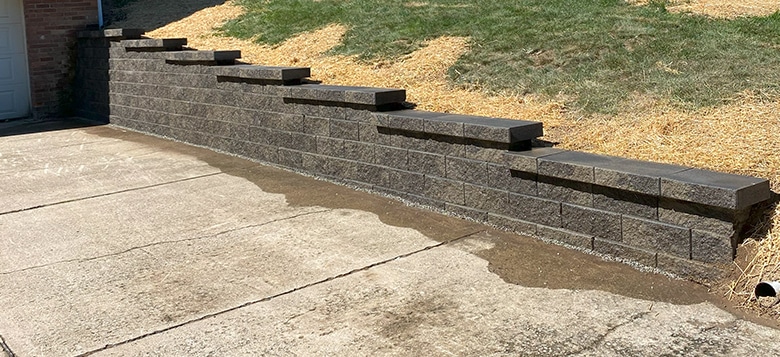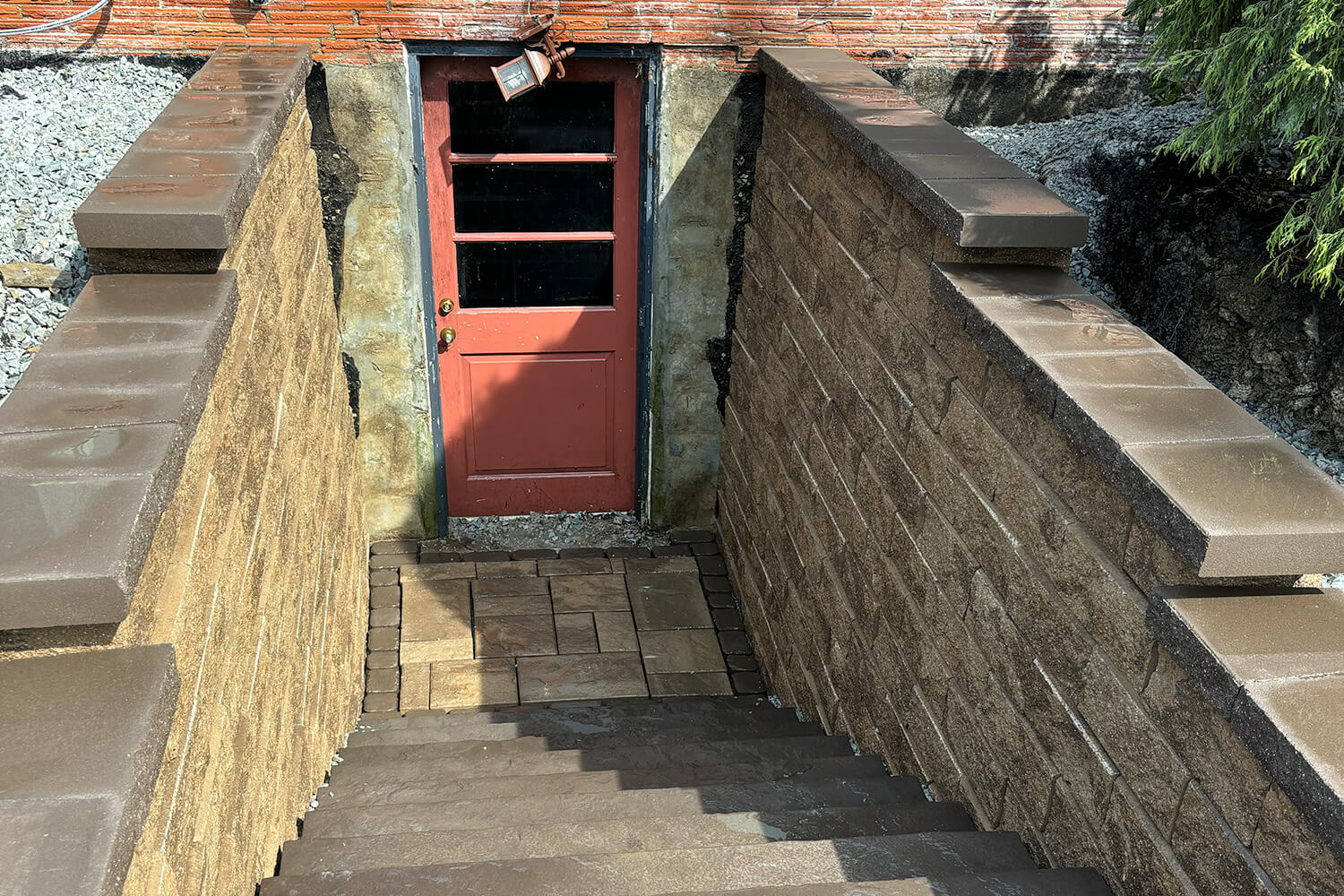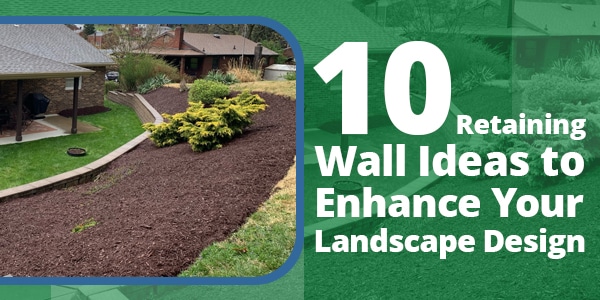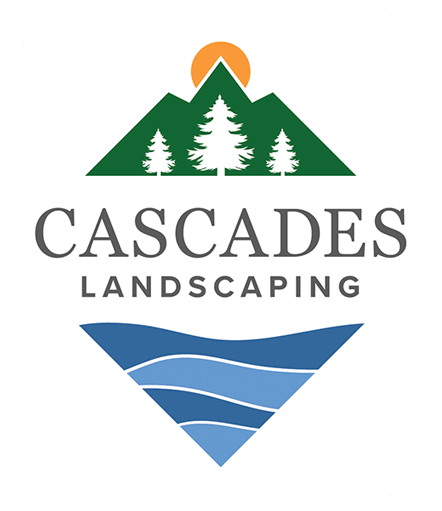Retaining walls are essential for managing soil and slopes in landscaping. They prevent erosion and create level spaces in your garden. In this article, discover the ten best retaining wall ideas to enhance your landscape design.
Key Takeaways
- Retaining walls are essential for managing soil and water in uneven landscapes, creating level areas while adding structural and aesthetic value.
- There are various types of retaining walls—gravity, cantilever, and tiered—each suited for different landscape needs and heights.
- Proper design and material choice are crucial for retaining wall durability and effectiveness; options include natural stone, precast concrete, and timber.
What is a Retaining Wall?
A retaining wall holds back earth or water, creating level areas in otherwise uneven landscapes. Designed to be vertical or near-vertical, these walls can add dramatic, elevated spaces to your garden or yard. In geotechnical engineering, they reinforce soil, increase bearing capacity, and resist differential settlement.
Retaining walls come in various forms like gravity, cantilever, and tiered retaining walls. Each type has unique characteristics suited for different applications, helping you choose the right one for your landscape needs.
The Purpose of Retaining Walls
In landscape design, retaining walls create level areas, support slopes, and maximize development space. They manage soil at varying elevations, stabilizing land and preventing soil from collapsing or sliding. This makes them essential in steep or engineered landscapes, optimizing available space.
Beyond their practical benefits, retaining walls enhance the aesthetic appeal of your landscape. They form attractive boundaries, add texture and depth, and create distinct zones for different activities. These walls also support basements and underground structures, offering essential stability.
Types of Retaining Walls
Several types of retaining walls address specific landscape needs. Gravity retaining walls use their weight to resist soil pressure, while cantilever retaining walls, made of reinforced concrete, transfer the load to the foundation, supporting higher walls.
Tiered retaining walls create multiple levels in a landscape, resembling steps. Knowing these types helps you select the best option for your landscape design.
Gravity Retaining Walls
Gravity retaining walls rely on their weight to resist lateral earth pressures. Ideal for lower heights up to 3 meters, they maintain stability and prevent soil from collapsing using the force of gravity.
Materials like stone or concrete blocks often construct gravity retaining walls, providing the necessary mass to counteract soil pressure. For walls exceeding 3 meters, alternative designs or reinforcements might be needed to ensure stability.
Cantilever Retaining Walls
Constructed using reinforced concrete, cantilever retaining walls have L-shaped or T-shaped sections that transfer the load to the foundation. This design supports higher walls, up to 5 meters, making them suitable for substantial landscaping projects.
Offering excellent stability and strength, these walls are preferred for taller retaining structures. Reinforced concrete ensures durability and longevity, even under varying environmental conditions, benefiting long-term landscape design.
Tiered Retaining Walls
Designed to create multiple levels resembling steps, tiered retaining walls offer a visually appealing solution for managing slopes. Effective for large landscapes with significant elevation changes, they break down height into manageable segments, reducing soil erosion and enhancing aesthetics.
Key Considerations When Designing Retaining Walls
Designing a retaining wall requires considering factors like lateral earth pressure, proper drainage, and ground-bearing capacity. Each element plays a critical role in the wall’s performance and longevity, requiring careful evaluation during the design phase.
Lateral Earth Pressure
Lateral earth pressure, the force exerted by soil against a retaining wall, can cause the wall to topple if not managed properly. The greatest pressure is exerted at the wall’s base, making it crucial for engineers to factor this into their design plans. Properly designed walls maintain structural integrity, safeguarding against potential collapse from environmental stressors.
Gravity retaining walls resist lateral earth pressure using their weight but are unsuitable for heights above 3 meters due to potential stability issues. Engineers must also consider internal slope drainage to let water drain and intercept groundwater flow, preventing negative pore pressure from causing wall failure.
Proper Drainage
Proper drainage maintains the stability and longevity of retaining walls. Incorporating weep holes and other drainage solutions prevents water buildup, reducing hydrostatic pressure and maintaining wall stability.
Managing hydrostatic pressure prevents water ingress and ensures the integrity of the retaining structure.
Ground-Bearing Capacity
Assessing ground-bearing capacity ensures the stability of the retaining wall, preventing settlement or structural failure. Adequate ground-bearing capacity maintains structural integrity under various load conditions.
Reinforced soil structures significantly reduce bearing pressures on foundations, contributing to overall stability.
Material Choices for Retaining Walls
Material choice for retaining walls impacts their durability, aesthetics, and maintenance needs. Options include natural stone, precast concrete, and timber, each offering unique benefits and considerations.
Choosing the right material ensures the retaining wall supports your landscape design goals effectively.
Natural Stone
Renowned for durability and aesthetic appeal, natural stone is a long-lasting choice for retaining walls. Its natural imperfections give each wall a distinct appearance, enhancing overall landscape design.
Combining durability with visual appeal, natural stone walls create striking outdoor spaces that endure over time.
Precast Concrete
Precast concrete, praised for quick assembly and high durability, is a popular choice for retaining walls. These walls are recognized for their strength and quick installation, reducing labor costs.
The modern aesthetic and structural benefits of precast concrete make it increasingly popular for various landscape projects.
Timber
Timber retaining walls are affordable and adaptable, known for their natural aesthetics and seamless blend with surrounding landscapes, though they require regular maintenance to prevent deterioration.
The simplicity of construction and integration with natural settings make timber popular among homeowners.

Enhancing Your Landscape with Retaining Walls
Retaining walls significantly enhance the visual appeal and functionality of your landscape design. Transforming sloped terrains into functional spaces, they improve both aesthetics and usability.
They can also serve as pedestals for plants, creating visually interesting layers and adding depth to your garden.
Incorporating Flower Beds
Incorporating flower beds into retaining wall designs adds natural texture and depth to your landscape. Retaining walls create defined spaces for flower beds, enhancing visual appeal.
Combining colorful flowers with stone or concrete walls softens hard landscaping elements, creating a harmonious garden design.
Adding Steps
Adding steps to retaining walls facilitates access between different levels of a property, enhancing functionality and visual depth. This integration allows easier movement between landscape levels, making the space more accessible and visually appealing.
Creating Seating Areas
Retaining walls can double as seating areas, offering both style and functionality. Designing retaining walls with built-in seating creates inviting outdoor spaces that are practical and aesthetically pleasing.
These unique seating areas enhance landscape usability while maintaining the wall’s structural function.
Retaining Walls for Different Landscapes
Retaining walls are versatile, adapting to various landscapes from sloped gardens to large properties. Small retaining walls stabilize slopes, prevent soil erosion, and maximize usable space.
Retaining walls define different areas in your landscape, creating distinct zones for various activities.
Sloped Gardens
Tiered retaining walls are effective in sloped gardens, creating flat areas for gardening and reducing soil erosion. They maximize usable space and enhance the overall functionality of sloped landscapes.
By managing erosion and creating level surfaces, tiered retaining walls transform challenging terrains into beautiful and practical garden spaces.
Small Yards
In small yards, vertical sleepers for mini retaining walls maximize space without making the area feel cramped. These small walls delineate spaces effectively and provide structure to the landscape design.
Conserving space and creating defined zones, mini walls are an excellent solution for smaller outdoor areas.
Large Properties
For large properties, gabion walls offer a robust and visually appealing option. Made from wire containers filled with rocks, they provide impressive durability and a natural appearance.
Suitable for significant elevation changes, these diaphragm walls add stability and aesthetic appeal to expansive landscapes.
Benefits of Professional Installation
Hiring professionals for retaining wall installation customizes the design to fit your property’s unique features. A professionally built wall enhances property value and visual appeal, making it more attractive to prospective buyers. Professional installation saves time and money by avoiding costly DIY mistakes. Experienced contractors provide ongoing support and maintenance, ensuring long-term effectiveness.
At Cascades Landscaping, we deliver exceptional service and quality workmanship. Our team collaborates with clients to create outdoor spaces that reflect their personal aspirations and enhance their property’s overall appeal.

Our Commitment to Quality
At Cascades Landscaping, we reshape outdoor areas to mirror our clients’ aspirations, ensuring their outdoor living spaces become havens. Our collaborative approach involves working closely with clients to understand their vision and transform it into reality. Combining skill and passion, we create landscapes that are beautiful and functional, providing enjoyable outdoor experiences.
We prioritize excellence in service, ensuring every project meets the highest standards of quality and durability, delivering maximum value. Customer satisfaction is central to our commitment, and we strive to exceed expectations in every aspect of our work.
Summary
Retaining walls are powerful tools in landscape design, offering both practical and aesthetic benefits. They support slopes, create level areas, and enhance the visual appeal of outdoor spaces. By understanding the different types of retaining walls, key design considerations, and material choices, you can make informed decisions to elevate your landscape.
Whether you’re dealing with sloped gardens, small yards, or large properties, retaining walls provide versatile solutions to meet your needs. Professional installation ensures that these structures are built to last, adding value and beauty to your property. Embrace the potential of retaining walls and transform your outdoor space into a stunning and functional haven.
Frequently Asked Questions
What is a retaining wall?
A retaining wall is a crucial structure that holds back soil or water, enabling the creation of flat landscapes and supporting inclines. Its primary function is to prevent erosion and manage land stability.
What are the main types of retaining walls?
The main types of retaining walls are gravity retaining walls, cantilever retaining walls, and tiered retaining walls, each designed for specific applications and varying heights. Understanding these options can help you choose the right solution for your project.
Why is proper drainage important for retaining walls?
Proper drainage is essential for retaining walls to prevent water accumulation and hydrostatic pressure, which can undermine their stability and durability. Ensuring effective drainage safeguards the structure’s integrity over time.
What materials can be used for retaining walls?
Retaining walls can effectively be built using materials such as natural stone, precast concrete, and timber, each providing distinct advantages in durability and aesthetics. Selecting the right material depends on your specific project needs.
What are the benefits of professional installation for retaining walls?
Hiring professionals for retaining wall installation offers a customized design that enhances property value while saving time and money by avoiding costly DIY errors. Additionally, it ensures ongoing support and maintenance, leading to a more successful outcome.
Whether you’re dreaming of tiered gardens, functional seating areas, or simply a more stable and beautiful yard, the right retaining wall can make all the difference. Take the next step and contact Cascades Landscaping today for a personalized consultation. Let our experienced team guide you through material selection, design, and professional installation, ensuring your retaining wall not only looks stunning but stands the test of time. Call or text us today at 412-609-2732.

